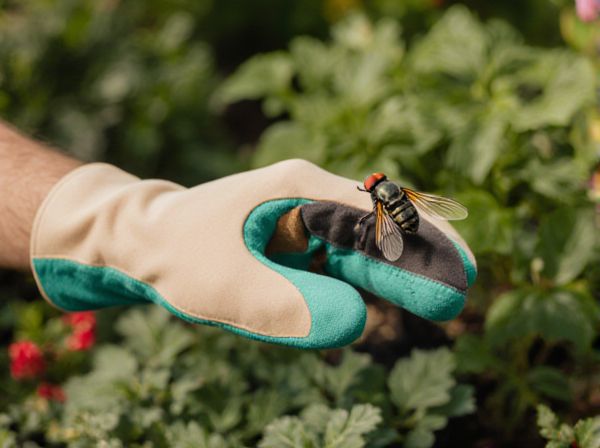
Hoverfly vs Moth Illustration
Hoverflies and moths both play crucial roles as pollinators, with hoverflies often visiting flowers during the day due to their excellent flight agility and preference for nectar-rich blooms. Moths, primarily nocturnal, contribute to pollination by visiting night-blooming plants, using their long proboscises to access deep floral nectaries. The complementary activity patterns of hoverflies and moths enhance overall pollination efficiency across various ecosystems.
Table of Comparison
| Feature | Hoverfly | Moth |
|---|---|---|
| Pollination Efficiency | High; visits diverse flowers, effective pollen transfer | Moderate; mainly nocturnal pollinators, limited flower range |
| Activity Period | Daytime | Nocturnal |
| Appearance | Mimics bees or wasps; brightly colored | Varies; often dull or patterned wings |
| Flight Ability | Able to hover and maneuver precisely | Strong flyers but less agile in hovering |
| Habitat Preference | Gardens, meadows, agricultural fields | Forests, gardens, grasslands |
| Role in Ecosystem | Key pollinator for many crops and wild plants | Pollinates night-blooming flowers; food source for predators |
| Lifespan | 2-4 weeks | 1 week to several months depending on species |
Hoverfly vs Moth: Key Differences in Pollination
Hoverflies and moths serve as vital pollinators with distinct behaviors and ecological roles; hoverflies are diurnal, favoring brightly colored flowers and contributing to pollination through their frequent visits and nectar feeding, while moths are predominantly nocturnal, attracted to pale or white blossoms emitting strong scents at night. Hoverflies exhibit rapid, hovering flight patterns enabling precise flower visitation, whereas moths rely on their long proboscises to access deep floral nectar, often pollinating species inaccessible to other insects. These differences influence plant-pollinator interactions and biodiversity, emphasizing the complementary roles of both hoverflies and moths in maintaining ecosystem health.
Morphology: Identifying Hoverflies and Moths
Hoverflies exhibit large compound eyes that often meet at the top of the head and short antennae, while moths typically have feathery or filamentous antennae and scaled wings covered in tiny overlapping scales. Hoverflies' bodies mimic bees or wasps with bright yellow and black patterns, but their wings remain clear and only one pair is visible in flight, distinguishing them from moths which have two pairs of scaled wings that can appear muted or brightly colored. The resting posture also differs: moths often fold their wings tent-like over their bodies, whereas hoverflies hold their wings out flat or slightly forward.
Pollination Efficiency: Hoverflies Compared to Moths
Hoverflies exhibit higher pollination efficiency than moths due to their frequent flower visits and preference for daylight foraging, which aligns with many plant species' peak nectar production. Hoverflies' rapid movement and ability to effectively transfer pollen between flowers enhance cross-pollination rates, whereas moths, primarily nocturnal, contribute to pollination of fewer plant species with lower visitation frequency. The structural adaptation of hoverflies, including their hairy bodies, facilitates better pollen adherence compared to the smoother bodies of most moths.
Activity Patterns: Daytime vs Nighttime Pollinators
Hoverflies primarily function as daytime pollinators, actively visiting flowers during daylight hours when sunlight enhances their navigation and foraging efficiency. Moths predominantly act as nighttime pollinators, using their keen nocturnal vision and olfactory senses to locate flowers that emit strong fragrances after dusk. This temporal separation in activity patterns reduces competition and allows for diverse pollination strategies across different plant species.
Flower Preferences: Hoverfly vs Moth Choices
Hoverflies predominantly visit open, shallow flowers such as daisies and umbellifers, favoring nectar-rich blooms with easy access. Moths are drawn to night-blooming flowers that emit strong scents and have pale or white petals, facilitating visibility in low light. The distinct floral preferences of hoverflies and moths reflect their adaptations to diurnal and nocturnal pollination niches respectively.
Hoverfly and Moth Life Cycles in the Garden
Hoverflies undergo complete metamorphosis with egg, larva, pupa, and adult stages that contribute to pest control and pollination in gardens. Moths also experience complete metamorphosis but their larval stage, often known as caterpillars, can feed on garden plants, sometimes causing damage. Understanding the life cycles of hoverflies and moths helps in promoting beneficial species while managing those that may harm garden health.
Attracting Hoverflies and Moths to Your Garden
Plant a variety of nectar-rich flowers such as fennel, dill, and alyssum to attract hoverflies, which are effective pollinators and natural pest controllers. To draw moths, incorporate night-blooming plants like evening primrose and yucca that emit strong fragrances after dusk, encouraging nocturnal pollination. Creating diverse habitats with a mix of flowering times enhances the presence of both hoverflies and moths, promoting a balanced and thriving garden ecosystem.
Benefits of Hoverflies over Moths for Pollination
Hoverflies exhibit superior benefits over moths for pollination due to their higher daytime activity, enabling efficient pollen transfer across a wider variety of plants. Their larvae consume aphids, providing natural pest control which supports healthier crops and ecosystems. Hoverflies also display greater flower specificity and frequent visitation, enhancing pollination quality compared to the more nocturnal and less selective moths.
Challenges Facing Hoverflies and Moths
Hoverflies and moths both face habitat loss and pesticide exposure, which reduce their populations and pollination efficiency. Hoverflies struggle with fragmented landscapes that limit flower availability, while moths are challenged by light pollution disrupting their nocturnal activities. Climate change also affects their life cycles and synchronization with flowering plants, threatening ecosystem stability.
Supporting Pollinator Diversity: Why Both Matter
Hoverflies and moths each uniquely enhance pollinator diversity, with hoverflies excelling in daytime pollination due to their attraction to bright flowers, while moths contribute primarily through nocturnal pollination of night-blooming plants. The complementary activity patterns and floral preferences of these insects support a wider range of plant species, fostering robust ecosystems. Maintaining habitats conducive to both hoverflies and moths ensures critical pollination services and promotes biodiversity resilience.
Hoverfly vs Moth Infographic

 gardendif.com
gardendif.com